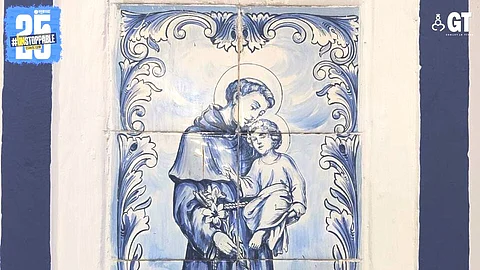

Tucked along the road that once connected the port of Agassaim (in Tiswadi) to Old Goa — a route in use since the time of the Kadamba dynasty — is the Chapel of St Anthony in Goa Velha. This centuries-old shrine is deeply woven into the spiritual fabric of the region and attracts people from across religions.
“I was once taken to the St Anthony’s Chapel at Goa Velha, and I felt a sense of calm there,” shares Marcina Viegas, a devoted follower. “My prayers flowed naturally, like a conversation with a friend. Since then, only good has come into my life. And with that, my devotion to him and my overall faith have grown stronger.”
The chapel’s origin is tied to a nobleman, Dom Joao Antonio de Melo, who was visually impaired.
Historical accounts and oral tradition say that Dom Joao was once traveling in a machila (a kind of palanquin) from Agassaim to Ribandar. Around midday, the bearers stopped to rest under a large mango tree near a small chapel, managed by the Pilar Monastery.
Nearby stood a statue of St Anthony, mounted atop a coconut tree trunk.
I was once taken to the St Anthony’s Chapel at Goa Velha, and I felt a sense of calm there.
Marcina Viegas, a devotee of St Anthony
At this resting spot, the bearers reportedly said, “Hanga firgeancho sant asa” (a foreign saint is here). Moved by those words and his own longing for healing, Dom Joao offered a prayer to St Anthony, vowing that if his sight was restored, he would build a chapel in the saint’s honour.
What followed was nothing short of miraculous.
On his return journey through the hills, Dom Joao began to see faintly. He asked to be taken back to the statue, where he saw even more clearly.
Upon reaching home, he walked to his manor unassisted — a moment that deeply confirmed his belief that St Anthony had interceded on his behalf. True to his word, Dom Joao sent a registered letter to Portugal, requesting architectural plans to build a chapel in Goa.
Upon reaching home, Dom Joao walked to his manor unassisted, a miraculous moment that deeply confirmed his belief that St Anthony had interceded on his behalf.
The chapel was likely completed around 1752, though local tradition places its establishment even earlier, on May 15, 1639. A life-size statue of St Anthony was installed — one that continues to draw the faithful from across Goa and beyond centuries later.
To this day, the statue is brought out in a procession and venerated every Tuesday, a tradition that has endured for generations.
The chapel also houses the relics of St Anthony, believed by many to be miraculous. Devotees of all faiths gather here to seek intercession for personal needs, offer oil and candles, and return later with prayers of gratitude.
It is not uncommon to find people kneeling and fervently praying on Tuesdays, at any time of the day. The family that lives adjacent to the chapel are the caretakers of this serene chapel and work towards its upkeep and maintenance.
People of every background come here because they’ve felt something real — comfort, healing or simply a sense that they are not alone.
At the Chapel of St Anthony in Goa Velha, it’s not just about the grand celebrations on his feast day in June.
People of every background come to worship St Anthony here, because they’ve felt something real, be it comfort, healing, or simply a sense that they are not alone.
Every Tuesday, the saint’s presence is felt in whispered prayers, flickering candles, flower garlands, pouring of oil and quiet acts of gratitude. It’s in these simple moments that faith comes alive, not just as tradition, but as a divine connection between the people and the saint.
Week after week, Tuesday after Tuesday, this humble chapel becomes a sanctuary where hope is rekindled and miracles are quietly believed in.